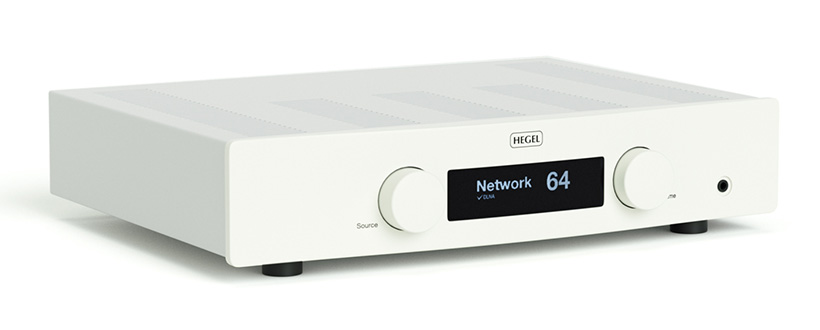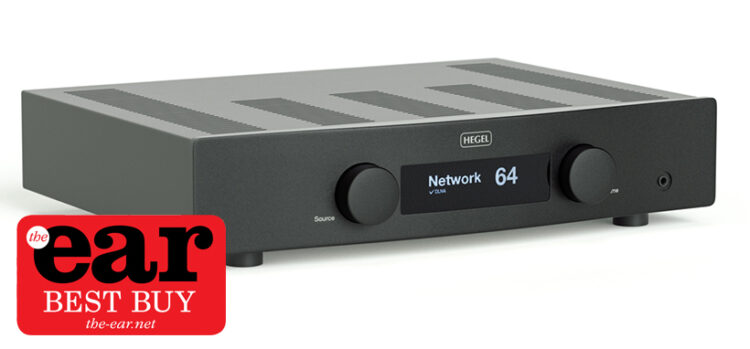Readers may recall that I wrote enthusiastically about Hegel’s entry-level Röst integrated amplifier/DAC back in 2017 and was very excited when an upgraded replacement was announced late last year. The Hegel H120 is born and, to all intents and purposes, looks almost identical to the Röst which I have continued to use with great satisfaction.
For those who missed the original review, we have a Norwegian-designed package that is relatively affordable and yet highly competent. It offers a significant step-up in terms of performance over lesser models and yet costs only slightly more. Assembled in the Far East to reduce overheads, significant parts of the design are based on the larger Hegel models – notably the digital section which is the major difference over its predecessor, with improved networking and embedded Roon compatibility, as well as Spotify Connect. In essence we have the analogue section from the trusty Röst and the digital part from the mighty H190 which has become a personal reference product and my everyday amplifier/DAC.
The H120 has ample digital and analogue inputs alongside Apple Airplay, Spotify Connect, IP Control, Control 4 and UPnP streaming built-in, as standard. Connect a pair of speakers and there’s a ready-made music system in one box. We are promised even more, which will be offered at no extra cost and be easily updated via software download when the time comes. For those who wish to integrate the unit into a home theatre system, or with Bluetooth or Sonos, all inputs are configurable for volume bypass. The DAC supports three sampling rates via USB (44.1, 48 and 96kHz) whereas via UPnP it supports PCM up to 24-bit at 192kHz. It will replay files with other sampling rates, cunningly re-sampling them before decoding.
Technology
At its heart, alongside the high-resolution DAC, the H120 uses Hegel’s SoundEngine2 amplifier platform providing an impressively high damping factor (the relationship between an amplifier’s output impedance and the loudspeaker load) in excess of 2,000, along with extremely low distortion levels. The circuit works rather like noise-cancelling headphones: comparing the amplifier’s output with the input signal, detecting the distortion and sending this in reverse-phase to the output to cancel it. The technology has been refined over some 30 years from designer Bent Holter’s initial concept and the evolution comes from an investment of millions of dollars.

Internally, the over-sized toroidal transformer and its smaller sibling stand out and have been implemented to create a more dynamic sound, allowing the unit to be used with larger loudspeakers which can have quite challenging loads. The larger transformer has separate secondary windings for each channel, feeding independent rectifier blocks and filter capacitors. As is usual with Hegel designs, we have two power supplies: one for the current output stage, another for the input and voltage-gain stage to avoid high current demands in the output affecting the sensitive input and gain sections. Externally, the fascia remains dominated by an OLED screen to display source, volume and details such as sampling rate. The otherwise minimalist, three-footed casing houses a source select knob and volume control along with a full fat headphone socket.
The supplied remote control is one of the best in its class, feeling satisfyingly solid in use and affording all the playback adjustment one needs including control of a computer attached to the amp’s USB socket. There’s the ability to alter volume, mute, cycle through sources and operate Hegel’s DACs and CD players. Power output is quoted at 2 x 75W of Class A/B into 8W, a quite believable figure, that has enough grip to cope with a minimum load of just 2W. For those wanting more than the inbuilt streaming capabilities, there are three optical and one coaxial digital inputs as well as USB and network connections, although only Ethernet and no inbuilt wi-fi; these alongside two unbalanced and a single ended analogue input. Usefully, there is a variable line output allowing connection of a power amp or monoblocks to use the ‘120 as a preamplifier.
A new power stand-by mode has been incorporated, allowing the ‘120 to be woken up over LAN by Airplay or Spotify – an extremely useful addition. Meanwhile, Hegel’s proprietary DualAmp technology is described as separating the current-gain stage and voltage-gain stages which are often combined. Instead, separate circuitry is used for each to reduce distortion and improve dynamic range. Sonically this would seem to be so. Meanwhile, DualPower circuitry supplies the output stage with a different power feed from that of the input and voltage-gain stages, again for improved distortion and dynamic range figures. Another Hegel ‘special’ is SynchroDAC technology, designed to use true balanced signal processing to preserve dynamic range and low distortion, also lowering jitter and conversion errors to “allow the most faithful digital-to-analogue conversion possible”. Certainly a lot of careful thought has gone into each stage of Hegel’s circuitry (and marketing – Ed).
Hegel anticipate the use of a myriad third-party apps, such as mConnect, for network streaming of locally-stored music files using either an Android or iOS device. Alternatively, users can couple a media server such as Innuos to stream directly via USB which adds music streaming services such as Tidal and Qobuz as well as internet radio to the system.

Sound quality
I had become used to the Röst’s constantly crisp, clean and dynamic sound from a variety of sources and driving no-end of speakers as they passed though the listening room. The dynamics were believable, the bass deep and, more importantly, well-controlled to transport the listener to the recording venue.
Initially connecting my ‘old school’ BBC-style Harbeth monitors I was eager to couple the H120 to the hefty new AE509floorstanders from Acoustic Energy which had just arrived. Wow, can they shift some air and the Hegel amp proved a great driver for these larger-than-life transducers.
Dabbling with Spotify for the purpose of review, all went well although I was happy to be back in more familiar territory with Apple AirPlay which worked perfectly as I whiled away an evening streaming some of my favourite tracks from Apple Music and Tidal.
Hegel have included UPnP/DLNA playback and I was soon streaming tunes from my MacBook Air using the Audirvana music-player over my local network. I enjoy live concerts and soon had a satellite receiver connected to one of the H120’s optical inputs and was transported (metaphorically, at least) to several venues including London’s Wigmore Hall for a BBC Radio 3 lunchtime concert which provided a good test of the DAC section. Needless to say, it passed with flying colours. Dynamic range was superb and I was delighted by the quantity of micro-detail the setup provided.

A final listen via headphones confirmed Hegel’s claim that the output has a lower noise floor than with the earlier Röst. While the much more expensive H190 has dedicated HP circuitry, with the H120 it is derived from the speaker output but proved that it is more than a mere ‘extra feature’.
Among the highlights of an enjoyable four-week listening audition were some old favourites, new recommendations and live-stream recitals. I began with a succession of Mozart piano sonatas in the highly capable hands of Peter Donohoe (SOMM Recordings) where the wonderfully sonorous performance was conveyed with all its magic, courtesy of the Hegel. The tempo is beautifully maintained and the pianist’s sensitivity preserved as he clearly revels in the passages with the most intricate finger work.
Onto choral works and Britten’s glorious Noye’s Fludde (Decca, ECO, Britten at the piano and the Wandsworth School Boys’ Choir), here the composer’s boisterous high spirits are not only retained but brought to the listening room in a most convincing and involving manner to produce invigorating listening. It may be a recording from 1961, but is none the poorer for that as the vivid enthusiasm of the performers is truly infectious. The level of detail is staggering, with pinpoint imaging of the various instruments used to represent the 49 different animal species mentioned in the text, from the recorders, bugles, violins and handbells.
During another prolonged listening session I focussed on rock and pop, my foot involuntarily tapping to Paul Simon’s ‘Graceland’ which seems to produce something new with each hearing, and this time was no exception: the warmth and melody oozing from the Hegel’s circuitry and bringing a smile to this listener’s face.

Album after album, track after track, the H120 excelled in its dynamic capabilities and ability to maintain the tempo: a true success for all ‘pace, rhythm and timing’ fans. Any fears that dramatic passages (such as in Mahler’s Eighth) might end up compressed and harsh were completely unfounded, as transparency was retained to a higher degree than expected by the 75 Watts on tap. Neutrality was also to the fore as speech recordings were handled with aplomb and I had no nasty surprises from my usual test tracks.
Conclusion
Aimed primarily, I hesitate to suggest, at the music lover who uses digital streaming – and rightly so because in this respect the H120 is a winner just as the Röst was – it was in this mode that I enjoyed the product the most for its simplicity of operation. Sonically it passed muster in a variety of configurations including my MacBook Air connected via USB and a satellite receiver through an optical digital connection.
The sheer ability to stream effortlessly using AirPlay makes the H120 a winner for me, let alone the Spotify and Roon ability, and all the other features. My only regret is losing the Röst name in favour of a rather anodyne nomenclature. An initial annoyance that the unit switched itself to standby after a period of ‘no signal’ was soon resolved via the user settings. Apparently, to comply with dreaded EU regulations, the amplifier has to be supplied like that, but can thankfully be configured to restore user control.
Once again, Hegel has done its magic. The H120 is a significant improvement over the already highly competent Röst design. While on paper there may appear to be cheaper alternatives, as with so much in life here is an example of getting what one pays for and, surely, sonic superiority is what we are seeking. With the Hegel H120 we get it. This is a winner in every respect.


